
5 common houseplants and flowers that are most toxic to cats
While cats are not as likely to eat everything that they come across without thinking twice as some dogs will, there are several common and popular plants and flowers that many people keep in their homes that are toxic to cats, and that can potentially pose a health risk to your cat if they are ingested.
Cats won’t usually deliberately eat plants other than catnip and plain grass on occasion to help with their digestion, but poisonous plants and cut flowers can still pose a potential hazard to your cat nonetheless, as your cat can inadvertently ingest some of the relevant toxins simply through indirect contact.
Pollen is apt to drop from many flowers and end up on the floor, walls and your cat’s coat or paws, and can then be ingested when your cat grooms themselves, and as different parts of different plants can potentially be poisonous to cats, a good rule to follow is to keep plants that may be toxic out of your home entirely.
In this article we will look at five of the most popular and common houseplants and decorative flowers that can be toxic or poisonous to cats-ensure that you keep them away from your own cat, and spread the word to your friends too!
Lilies
Lilies are one of the best known and most common household plants or flowers that can be toxic to cats, and this is something that most cat owners are now aware of, thanks to awareness-raising campaigns that have run over the last few years. Virtually all types of lilies are toxic to cats, both pot plants and cut flowers, and the main risk from lilies comes from the pollen itself, which tends to be prolific and apt to drop all over the home.
There is no sure-fire way to keep lilies in a home with cats safely, and so the best way to keep your cat safe is to ban both potted lilies and cut flowers from any form of lily from your home entirely.
Aloe Vera
Aloe Vera extract is contained in a huge range of different health and beauty products, thanks to its cooling, soothing properties. Because it is so bland, unscented and gentle, as well as being widely associated with healing, it comes as a surprise to many cat owners to learn that Aloe Vera pot plants and cuttings can be dangerous for cats, because the sap itself is toxic for cats if ingested.
It is also important to ensure that you don’t use Aloe Vera gel or products without your vet’s approval on your cats too, for this same reason.
Poinsettia
Poinsettia is an evergreen plant sometimes known as a Christmas cactus, and that many people bring into their homes at Christmas, and then display throughout the year. While brushing against the plant itself is not likely to cause your cat any harm as Poinsettia does not drop a lot of pollen, the plant itself can be toxic if ingested, as the sap, leaves and stem are all toxic.
Crocus
Crocus flowers are small, delicate and beautiful, as well as reasonably hardy. Many people plant them in their gardens or keep small potted crocus plants in the house, and once more, your cat is not likely to come into contact with them deliberately, but all parts of the crocus plant including the roots, leaves and stem, flowers and pollen are toxic, so ensure that you don’t keep a crocus plant that is dropping pollen around the home, as this may be a hazard to your cat.
Ficus
The ficus plant is a green, leafy and narrow plant that is a popular medium to large-sized houseplant that many people find grows well in darker corners, such as in the bathroom or hallway. The sap of the ficus is a potential hazard to your cat, and while they are unlikely to deliberately eat the plant, the hanging leaves of it and the fact that they are often kept at floor level means that some cats will chew or swat at the leaves, which places them at potential risk from coming into contact with the toxic sap the plant can produce.
What is the risk?
When it comes to poisonous plants and your cat, the risks have to be assessed on a case-by-case basis-some plants are very toxic and yet highly unlikely to come into contact with your cat or be ingested, whilst other plants might only have a mild toxic effect, and yet if you keep them with your cat, your cat will be more likely to come into contact with it.
Lilies are potentially the biggest risk and toxin to cats because of the shedding pollen and the high level of toxicity that it causes in cats, but it is important to review any new plant you might be getting on an individual basis, to ensure that you make the right, safest decision before your cat is potentially exposed to it.



